

A few days before leaving for Antarctica we all go down to the Antarctic NZ clothing warehouse and get issued with various items of clothing designed to keep us from freezing during our stay on the ice. The Americans do the same thing. As I have stated elsewhere, we have to wear all our survival clothing on the plane ride down to Antarctica. This is a photo of our stay in the departure lounge before our flight leaves. NZ people are in blue or yellow, Americans and Italians are in red. It's one of those places where you just have to hurry up and wait. Our plane had a malfunction and we were delayed by 1 hour. Almost everyone in the NZ crew are wearing polyprop underwear, polarfleece bib overalls, winter weight Extreme Cold Weather (ECW) bib overalls over the top, a woolen or polarfleece shirt, polarfleece jacket, and an ECW down/synthetic mix ECW jacket. In our pockets we have stuffed our gloves, neck warmers, hats, etc. On the plane trip we are allowed to carry three bags. One of those with you and the other two are stored in cargo. We also weigh in a suitcase or two and the NZ team normally gets away with a bit because we don't take up much room in the big picture or personnel movements in Antarctica. I think it was a max weight of 70 Kg. We also packed alot of stuff into boxes and had it sent to us when there was more room on other flights.
Boots
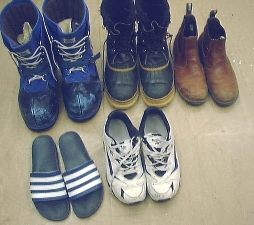
If you are part of the NZ winter over engineering team, you will get issued 3 pairs of boots.
The blue Mukluks to the left side are ECW quality. A bit clumpy to walk in but they are good for very low temperatures and if you want to guarantee warm feet in most situations, then wear them if you are going to be outside for extended periods of time.
Most people get a slightly bigger size than normal because a bit of an air gap around your toes helps to prevent heat loss. The boots come with liners that look like oven mitts for feet. The soles are very rigid and are designed to be fitted with crampons if required.. As I said your feet will float around in them a bit, but by tightening up the straps around your legs and ankles it reduces many of the problems.
The Sorrels in the middle (back) are steel capped boots and also have a liner in them. The liner can be either a sheep skin type or a heavy cotton type. I prefer the heavy cotton. These boots are not all as heavy as the type we engineers have to use. Most people wear the type without the steel cap and they are more like rubber slippers. These boots are good for temperatures down to about -30 deg C. Most of us find if it gets any colder, you have to keep moving, otherwise you cool down very quickly. Ideal for moderate temperatures of 0 deg C -30 deg C. They provide reasonable support but if you want to do alot of walking (and steel caps are not required for safety) then I suggest you acquire a pair of non steel cap boots which are much lighter and more comfortable. I was wearing these boots outside the other day at -47 deg C and after 90 minutes the rubber soles had frozen and my feet were starting to cool down. The lighter, non steel caps would not have stayed as warm for as long .
The normal work boots to the right are the safety boots issued to us. We use these for walking around inside the base while we are working. All the engineering team are issued with these. They are just normal slip on boots with steel caps and rubber soles. They are fine for short periods of time outside as long as the temperature is moderate, under -25 deg C.
The slip on sandals are what I bought before I came down here. They are great for wearing after work inside the base. Most of us wear these or something similar at certain times of the season and are absolutely no good for outside.
The cross trainer gym shoes are something else I bought before coming down. I use them all the time for wearing both inside and outside the base. I often go running up the hill behind the base or out on the permanent ice towards the airfield. I have worn them at -30 deg C when running outside for up to an hour. They are fine as long as you don't stop and let them get cold. While running you generate alot of heat which your body kindly pumps around. The trick is not to stop until you can get back into the shelter of the base. Around the base they are good because I don't tie up the laces, I just flick the laces into the shoe, and they make good slippers.
The general rule of thumb around the base is to have reasonable footwear on your feet at all times . This is due to the possibility of manning the fire stations at any time. In an emergency we have to react quickly and reasonable foot wear is required for anything outside and fire fighting inside.
As with all footwear, what you wear outside is personal choice. You soon get to know which footwear is suitable for the weather conditions and the amount of time you will spend outside. You only get it wrong once !!
Gloves
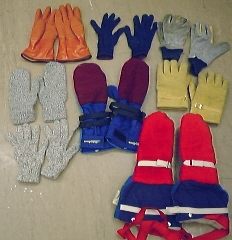
Left, top: These are a rubbery thermal insulated glove for use with fuels. If you get oil or fuel onto normal glove it transfers the heat away from you skin and you quickly freeze. These gloves are good but in cold conditions like -45 deg C which we worked in the other day (18-4-98) the rubber in the gloves goes hard and makes them unusable.
Middle, top: Poly prop gloves. These thin gloves are Ok by themselves in very mild conditions (around -8 deg C) but they offer no protection againnst wind or extreme conditions. They do, however, make very good glove inners when combined with other gloves. There are also fleece gloves (which I haven't shown here but look very similar ) made from a heavier version of polyprop material. There is also a variety called Damart gloves which are just as good, if not better, which look almost identical but just a little less fleecy looking. The fleece/Damart gloves are an excellent all round glove for temperatures down to -25 deg C as long as there is not too much wind
Right, Top: Leather work gloves with virtually no insulation, but when combined with thin polyprop gloves they are semi OK for temps down to -25. The biggest advantage with these is the hard wearing nature of the glove; cheap and nasty in these environs !!
Middle, bottom left: Woolen mitts which are hopeless for these conditions. Most of us don't know why we are even issued them. The weave of the wool is so open to the slightest breeze that your hands quickly freeze. If used in conjunction with a windproof mitt over the top they are reasonably comfortable but you are better off using the fleece gloves which can offer a higher protection on their own in case you need to take off the clumsy outer windproof mitt to do delicate work. The woolen gloves and mitts are also so bulky they don't mix and match well with other gloves.
Middle, middle: These are excellent over-mitts made by Fairydown. They provide not only a windproof outer but also a thermal barrier for most conditions. Normally used as part of a glove combination they are small and light but are very comfortable to wear or carry with you when you the weather turns a bit colder.
Right middle These are a pair of Carhartt gloves. Used by the Americans, they are a leather work glove with a thermal insulation on the inside; very practical and alot warmer than the cheap leather gloves we get issued. As the weather gets colder a thermal liner like the polyprop glove can be used inside these to stop a bit of the cold. The Americans also use other thermally lined work gloves (both leather and heavy cotton). They have put a bit of thought into the conditions peoples hands have to work in.
Right, bottom. Large nose wipers. (that's what they are called !!) These are large, heavy over-mitts for use on skidoo travel or extreme cold weather where your hands may be exposed for long periods of time. Very warm, but very bulky and no good for doing anything other than keeping your hands warm..
Summary. If you're coming down to Antarctica with the New Zealand crew and you think you will be doing any work outside then:
(1) Buy yourself some decent thermally insulated work gloves. You will save yourself the pain of thawing out your fingers on a regular basis (and believe me it hurts real bad at times if you let them get too cold for too long). Also, make sure they fit correctly and have enough room to fit a thin pair of polyprop gloves inside them if possible. Even a few pair of thinsulate lined ski gloves would be a great improvement on what you will be supplied, as of 26.4.98 (They may improve in the future but I dont know when it will happen)
(2) When you are being kited out in the Antarctic NZ clothing store, make sure you get several pairs of fleece gloves and don't worry about the woolen gloves as I have yet to see anyone wear them. The hardest part will be convincing the storeman to give you extra pairs, so get ready to stand your ground and argue heaps. Remember you are the one who is going to use them.
Jackets, Hats, Neck Gaiters, Leggings.
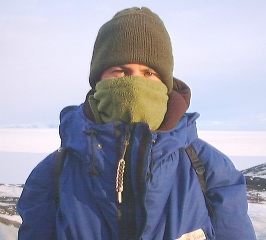
This is little old me during a balmy -20 deg C day with about 15 knots of wind. Its not really cold but the wind is a bit nippy. We (Helen and I ) are walking from Mactown back to Scott Base after a cup of coffee and a look around the shop. Just a quick note about the jacket I'm wearing You will notice a green and white zipper pull attached to the zipper. Its very handy to learn how to make them or find something to use as one. When you have gloves on your hands most of the time and your bundled inside a big jacket, a zipper pull becomes very handy.
My Hat is a
woolen balaclava that is doubled back. Its Ok in mild conditions
but is no good if the wind gets too strong. I normally use a
balaclava (woolen or polarfleec) because if I don't have a neck
gaiter on (which is not often) it can be folded down to stop the
wind getting around my face and throat. We are also issued with
opossum fur-lined hats. They are very warm comfortable in the -35
to -50 degree temperatures. If it gets really cold I will use the
hood on my jacket to stop the wind and cold. Everyone has
different hats they like to wear and it also depends on the
temperatures and how long you will be out in the cold as to what
is safe to wear.
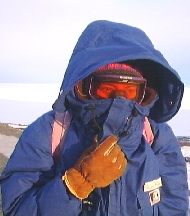
The Neck Gaiters are often used instead of scarves because they are smaller and provide a high degree of insulation against the cold and wind. They are just a tube of material with elastic or draw string in one end so you can keep it up on your face and the other end is tucked down inside your clothing to stop the wind from getting down you neck.
Jackets. The New Zealand survival jackets are made from a very windproof material with the ability to take moisture away from the body. Many Americans are envious of the jackets we are issued. The jackets are lined with down feathers for good moisture wicking and heat insulation properties. They are also extremely light and comfortable to wear. Most of us prefer to take these jackets wherever we go.
In this picture Helen is also wearing the standard issue goggles to stop the wind biting into her eyes and the woolen lined leather gloves she is wearing are ones she brought from home. After several years of working in the ski fields she knows how not to get cold.
Leggings. Legging are made similar to the jackets. Insulated and windproof, they provide protection around your legs and middle body as they are shaped like bib overalls with zips down the front and down the sides.
Windproofs. We also get issued with windproof jackets and leggings. They are the same as the other stuff without all the heavy insulating qualities. These are used in the summer for moderate conditions.
A couple of problems with the survival clothing ;
(1) It's not very rugged. The material rips very easily and if you are doing any engineering work outside you would quickly ruin it (later on I will show you clothing we work in). It's main use is for travel from one place to another and to keep you alive when weather conditions get really cold.
(2) None of the clothing is waterproof. In a place that it doesn't rain, they did not think it was necessary. The problem is that at certain times of the year the temperatures get high enough that the snow starts to melt and get slushy. When the snow hits your clothing it turns to water and the thermal insulation of the garment is compromised. Any grease or oils on the clothing will also reduce the thermal insulation qualities of the clothing
(3) If you work up a sweat in cold conditions the moisture that gets to the outside of the garment will quickly freeze and so the fabric becomes sealed. You might as well be wearing a plastic sheet over your clothing. In many cases your clothing underneath the jacket will also have a layer of frost. It's something you don't expect to see when you think you're warm. You sometimes have to wear less insulating clothing (even though you are colder ) so that you won't sweat so much. When you stop working you put more clothing back on.
(4) Polyprop underwear verses cotton or wool: Polyprop stuff is light and comfortable to wear but it does hold body odors. You can never stop it from stinking after constant use and it doesn't matter how many times you wash it. It gets to the stage where you are embarrassed to wear it. Cotton and wool don't have this problem but are a bit heavier and normally take up more room. Wool will often scratch the skin and cotton and wool don't wick the moisture away from the skin as well as polyprop. So, when it comes to underwear, take your pick !!
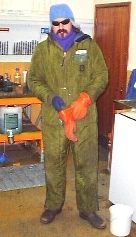
The Bunny suit:
Mike is just about to go outside and do some equipment checks. He
is wearing what we call the Bunny Suit. It a one piece overall
that has thermal insulation all through it. They are great for
general light duties if you're in a hurry. They have zips up the
side of the legs and a zip down the front so they are easy to get
in and out of with boots and other clothing. The zips do let in a
bit of the cold but they are very hand for working outside.
If you have a close look at the picture you will see he is
wearing a windproof thermal insulating hat, neck gaiter,
sunglasses, bunny suit, poly prop glove inners, thermally
insulated rubber gloves, and normal steel cap leather boots. This
is the normal sort of stuff you would wear when going outside for
a short period of time to do any work in moderate Antarctic -25
deg.C temperatures.
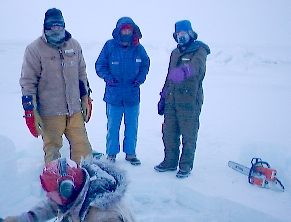
The other work gear we are issued are Carhartt combination overalls. This stuff is real heavy duty cotton outer with an insulation liner inside. Mike is wearing the Carhartt jacket on the jacket and a pair of old leggings. We prefer to use this stuff because it is more rugged and cheaper to replace, if damaged, than the normal ECW gear. If you get the option of being issued with Carhartt's and Bunny suit as well as the normal ECW gear, then take it. The Americans class the Carhartt gear for ECW use, but the New Zealand Scott Base crews don't.
Everyone has a different tolerance to cold and so we all develop a preference for what we wear in certain weather conditions.
This photo was taken on the 25-4-98, the day after the final
sunset before the long winter night. There is still a bit of
twilight around and we are digging out a hole so we can do a
polar plunge. The temperature has warmed up this week to about -25
deg C . Last week at the same time it was -50 deg C before wind
chill. We are taking turns digging out the hole in the 1.3 metre
thick sea ice. Chris at the bottom cuts the ice into blocks with
the chainsaw and then me (taking the picture), Dave (to the right)
and Mike ( to the left ) pull the blocks out of the hole. Eric (center)
has just come down from the base to have a look at how we are
getting on before going back inside. You can see the ice around
the neck gaiters as the condensation from our breath freezes. It's
not uncommon for your eyebrows and eyelids to have icicles on
them, which make it very hard to see.
Every-day clothing
If you're not working outside, then you are probably working inside, which means that you will be running around in jeans and T shirts all day. The inside temp of most places is around 20 deg C.
Cool running in Antarctica
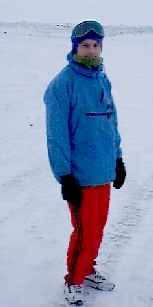
I am not an avid runner like some people, but I do enjoy getting out every now and then. When I took this photo in late February it was a moderate -25 deg C with about 10 knots of wind. I'm wearing a polyprop balaclava which I cover my face with, so I don't breathe the cold air directly into my lungs. Around that I also wear a neck gaiter to stop the wind around my throat and face. The goggles are there, so if the wind gets too strong I can cover and protect my eyes. Summer lenses are tinted to stop the glare but during the winter we put in a clear lens. The blue wind-jacket stops only the wind but underneath I'm wearing polyprop underwear and a t-shirt. The gloves are the simple fleece type and I often wear a windproof mitt over the top. The windproof leggings are just heavy nylon with a warm cotton lining. Heavy woolen socks and running shoes finish the outfit. Its all very light and not designed for a gentle stroll around Antarctica. This clothing only protects you against some of the elements (including wind and a little heat loss), the high exertion of running is meant to keep you warm.
Preparing for Antarctica (clothing,
etc.)
If I were preparing for Antarctica again, I would bring:
** Several pairs of jeans and track pants: Jeans wear out real quick in the dry conditions. Track pants are very comfortable to wear, and warmer than jeans so that's what I wore the most.
** Shirts, T-shirts, underwear, etc. I actually went out and bought new underwear, track pants, shirts etc. so that I knew it would last a full year. There is no point bringing down stuff that won't last.
** Sunglasses: something I didn't cover above. They do provide some cheap sunglasses and goggles. I just used my own sunglasses that I brought down with me. I didn't go out and buy special, expensive "sunnies" I just bought comfortable, practical sunglasses that cut out the glare. If the weather gets so bad that you need to have better sunglasses then wear the goggles they provide. Some sunglasses break if they get too cold or you get a bit rough with them, so a second pair is very handy to have. Sun is only a problem during the summer. During the winter it's dark 24 hours a day.
** Polar fleece jacket: We get supplied with a 300 weight polarfleece (also referred to as Ecofleece and several other brand names) jacket by the Antarctic program. I don't think the Americans do. The jackets are worn by everyone all the time and make both a good outer during the summer and a good inner (under a survival jacket) during the winter or inclement weather. If you have your own, as well as the one they supply you, then you will have more than enough. When selecting one, make sure it is nice and big and the zip goes all the way up a collar that has enough room for a neck gaiter to fit inside.
** Socks: Once again we are supplied with some heavy socks but you may want to bring your own as well. Remember this is Antarctica and if you don't have warm socks in your big boots, your feet will get cold and you may get blisters from your feet rubbing against the boot liners. Some gym socks are also handy to have for any sports or exercise you might do.
** Skin moisturizer and sun tan lotion: I have a suntan lotion that does both. Find something that works for you because if you don't you will get burned and your skin will dry out and flake. You have never seen skin dry out so fast until you come down to a place like this. Winter is the worst time but summer can also cause problems in some people with sensitive skin.
** Washing powder and soaps: Some soaps will dry out your skin and some laundry detergents will react with your skin in the unusual climate. If you're in doubt (and even if you're not), bring your own down with you. It's to late when you are down here to find out you're a bit sensitive. Stuff can be sent to you from friends, but mail/parcels can take a while to get to you.
** A set of good clothes: We have the occasional official function which could involve diplomats, foreign visitors and other high ranking officials. You just never know who you are going to meet down here. So bring some formal clothing and footwear as well as some nice casual stuff so you don't look like a hillbilly at the parties.
** Fancy dress: We have some really good parties down here where people relax a bit. Its often fancy dress or theme parties, so if you want to stand out in a crowd, think ahead to wigs, hats, costumes, water pistols, face paint, footwear, etc. For example have a look at the theme party where we did a mock wedding. We all went outside after the ceremony and took this picture in front of Scott Base. The are no actual females in this shot; just people doing their jobs as picked out of a hat. I was unlucky enough to get center stage and another wedding ring, which my wife found most amusing. (And yes, I am in white, standing!!) Now I know how she felt !! : ) . All good fun, and if you bring down some stuff, and an air for flair, then you will find these types of parties great.
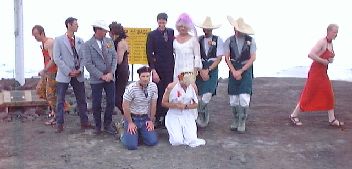
** Watches: I consider this part of your clothing. Make sure you have a new battery put in it before you come down and the wrist strap is ok. It's a bit late to find your semi-OK watch battery can't hack the pace of a cold climate.
** Shorts: Often worn by people around the base; just something different to break the monotony.
** Togs (swimsuits): Scott base has a hot tub and Mactown has several saunas. So unless you think people will appreciate only your birthday suit, then I suggest a slight case of modesty. The hot tub is only open in the winter and it depends on the individual about about the clothing policies.
** Kids, ask your parents before reading this. Talking about modesty and other related subjects, A friend of mine saw this page and pointed out that I talked about many forms of clothing used to protect yourself from the environment of Antarctica but I had forgotten to mention prophylactics. I suppose in a "lateral" form of thinking, they could be classed as a protective form of apparel. So with reluctance, and a smile, I will say a few words for the benefit of all the other University Food Technology Lecturers working in Palmerston North that may be interested.
Human behavior, in an environment such as this, creates relationships that may otherwise never have occurred. To stop any (3 to 9 month or after) visual effects, prophylactics are available at the clinic at Mactown free of charge. The prophylactics in question have to be kept at temperatures above freezing otherwise they are ruined, and so are any plans for the evening. The prophylactic dispenser is inside the clinic door but out of sight, so the shy people don't have to be seen gathering them by the armload. There was an interesting e-mail went around a few months back to say that, due to a shipment of the things being left outside and getting frozen, possible damage may have occurred. Anyone who had been using them in the previous 2 weeks should go immediately to the clinic for a check up. "Ha Ha Ha : ) !!! " I thought it was hilarious, but there were a few wide-eyed people around who weren't so amused. I never did find out if the email was true but I think the clinic was very busy that week. I must also say that even though they may have no effect against stopping the cold, they are a sure-fire way to warm up if used correctly. So Im told !! : ) .
** Most of all, bring those things you would normally wear around your own house; everyone else will be.
www.geocities.com/coolrunnernz/
9-3-01
Edited by Shirley Baston Fred [email protected] ICQ # 15167279